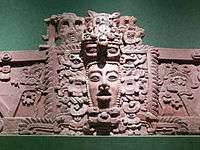Yo'nal Ahk III
| Yo'nal Ahk III | |
|---|---|
| ajaw of Piedras Negras | |
|
Yo'nal Ahk III's glyph | |
| Reign | 758–767 AD |
| Predecessor | Itzam K'an Ahk II |
| Successor | Ha' K'in Xook |
| Father | Itzam K'an Ahk II? |
| Religion | Maya religion |
Yo'nal Ahk III (Mayan pronunciation: [joːnal ahk]), also known as Ruler 5, was an ajaw of Piedras Negras, an ancient Maya settlement in Guatemala. He ruled during the Late Classic Period, from 758 to 767 AD. Yo'nal Ahk III ascended to the throne upon the death of Itzam K'an Ahk II, who may have been Yo'nal Ahk's father. He was succeeded by his probable brother, Ha' K'in Xook in around 767 AD. Yo'nal Ahk III left behind two surviving stelae at Piedras Negras, namely Stelae 14 and 16, the former of which has been called one of the finest niche stelae, according to Simon Martin and Nikolai Grube.
Reign
 |
| Maya civilization |
|---|
| History |
| Preclassic Maya |
| Classic Maya collapse |
| Spanish conquest of the Maya |
Yo'nal Ahk III, also known as Ruler 5, was likely the son of Itzam K'an Ahk II, based on Yo'nal Ahk III's fixation with venerating the mortuary temple of Itzam K'an Ahk II.[1][2] According to Walter Robert Thurmond Witschey and Clifford T. Brown, his name translates to "Black House Great Turtle".[2] Yo'nal Ahk III ascended to the throne of Piedras Negras on March 10, 758 AD (9.16.6.17.1 7 Imix 19 Wo in the Long Count), following the death of Itzam K'an Ahk II.[1] Not much is known about the ruler, nor his successor Ha' K'in Xook; Flora Clancy refers to both reigns as "shadowy".[3] James L. Fitzsimmons argues that Yo'nal Ahk III seems to have been a weaker ruler when compared to the reign of Itzam K'an Ahk II because Yo'nal Ahk III erected few monuments, and he did not reinforce his power on a larger scale, choosing only to do so at local polities like El Cayo and La Mar.[4]
Monuments at El Cayo record that Yo'nal Ahk III was involved in burial ceremonies for a sajal in 763 AD, although he was not involved in picking the leader's successor.[1] It is also known that during his reign, a k'ini' ajaw—or prince—of Piedras Negras, T'ul Chiik, was captured by Yaxun B'alam IV of Yaxchilan; it has been hypothesized by Martin and Grube that Yo'nal Ahk III's focus on smaller satellite kingdoms such as La Mar and El Cayo was a tactic to build up a support base in order to combat the growing threat that Yaxchilan posed.[1][5] He was succeeded by Ha' K'in Xook, who was possibly his brother.[6]
Monuments
Only two monuments survive today that were erected by Yo'nal Ahk III, Stelae 14 and 16. Stela 14, which Simon Martin and Nikolai Grube have called the "finest of all 'niche' monuments", is the king's accession memorial. It was probably raised in 761 AD, and it depicts an effigy of the king in a small hollow, or niche.[1] The monument was placed on the lower terrace of Structure O-13, and according to O'Neil, the stela's "form, imagery, and location acknowledged and responded to Structure O-13's participation in the processional circuit" of the site.[7] The front of the monument features not only the ajaw, but also his mother, who is positioned as a witness to her son; her positioning seems to imply that she had just arrived, by means of the processional route, from the West Group Plaza.[7] Stela 14 also includes the names of several sculptors and artists. These names are difficult to translate, since many are unique and not found in any other extant Mayan glyphic texts.[8]
Stela 16 celebrates the accession of a local sajal, or Maya leader, at the nearby satellite kingdom of La Mar. Tatiana Proskouriakoff had originally used this stela to misidentify the sixth ajaw of Piedras Negras, assigning the title to the sajal, instead of Ha' K'in Xook. The uniqueness of a La Mar ruler being celebrated on a Piedras Negras stela seems to signify that La Mar had, at the time of Yo'nal Ahk III and possibly earlier, attained a certain degree of importance in the Piedras Negras hegemony.[1] The front of the stela is eroded, but according to Megan O'Neil, it can be inferred that the monument had an image of Yo'nal Ahk III on the front, based on comparisons with other stelae at Piedras Negras, like Stelae 6 and 11.[9]
References
- 1 2 3 4 5 6 Martin & Grube 2000, p. 151.
- 1 2 Witschey & Brown 2012, p. 247.
- ↑ Clancy 2009, p. 135.
- ↑ Fitzsimmons 2010, p. 154.
- ↑ "Yo'nal Ahk III". Mesoweb Encyclopedia. Retrieved February 6, 2014.
- 1 2 O'Neil 2014, p. 185.
- ↑ Pitts, Mark (2011). "Royal Artists". A Brief History of Piedras Negras as Told by the Ancient Maya: History Revealed in Maya Glyphs (PDF). Pre-Columbian Society of the University of Pennsylvania Museum. pp. 146–153. Retrieved March 2, 2014.
- ↑ O'Neil 2014, p. 215.
Bibliography
- Clancy, Flora (2009). The Monuments of Piedras Negras, an Ancient Maya City. University of New Mexico Press. ISBN 9780826344519.
- Fitzsimmons, James (2010). Death and the Classic Maya Kings. University of Texas Press. ISBN 9780292781986.
- Martin, Simon; Grube, Nikolai (2000). Chronicle of the Maya Kings and Queens. Thames & Hudson. ISBN 9780500051030.
- O'Neil, Megan (2014). Engaging Ancient Maya Sculpture at Piedras Negras, Guatemala. University of Oklahoma Press. ISBN 9780806188362.
- Sharer, Robert; Traxler, Loa (2005). The Ancient Maya. Stanford University Press. ISBN 9780804748179.
- Witschey, Walter Robert Thurmond; Brown, Clifford (2012). Historical Dictionary of Mesoamerica. Scarecrow Press. ISBN 9780810871670.
